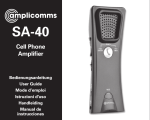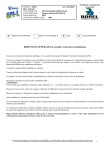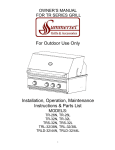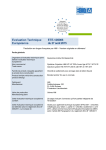Download aquí
Transcript
Soluciones Hilti para aplicaciones sísmicas Hilti, el consultor de los especialistas en diseño sísmico. Hilti. Superando expectativas. 6 7 6 8 9 5 2 El diseño sísmico y la especificación de productos adecuados es crucial t Aplicaciones estructurales sísmicas relevantes Las conexiones estructurales son de vital importancia para asegurar que la estructura responde de manera adecuada y predecible a un terremoto. Por ello, las conexiones deben estar definidas claramente en la fase de diseño para asegurar que, tanto los contratistas como Dirección Facultativa, construyen las especificaciones del proyecto. Soluciones bien ideadas es la mejor manera de asegurar que el producto diseñado es el que se utiliza realmente en obra. Aplicaciones no-estructurales sísmicas relevantes Los anclajes son, a veces, utilizados para fijar componentes no estructurales. Su diseño y elección es, por ello, crucial en términos de minimizar tanto posibles daños a los ocupantes de la edificación como los costes asociados a los terremotos. Como el fuego es una consecuencia común tras un terremoto, los sistemas de protección pasiva contra incendios deberían ser especificados de acuerdo con su capacidad para resistir una deformación extrema. Refuerzos sísmicos (por ej., arriostramientos, refuerzos de Conexiones metálicas no estructurales y fijación de servicios cortante) Placas de anclaje Conexiones corrugadas a posteriori Fijaciones de cerramientos a estructura principal Equipamientos Soportes de instalaciones mecánicas y eléctricas Sistema de fachada ventilada y muro cortina Sistemas de protección pasiva contra incencios (sellado de juntas y pasos de instalaciones) 2 www.hilti.es Soluciones Hilti para aplicaciones sísmicas 7 6 4 5&EXLOGLQJDYHUDJH 9 6WUXFW 6 1RQVW &RQWH 5&EXLOGLQJDYHUDJH 3 2IILFH 1 6 6WUXFWXUDO 1RQVWUXFWXUDO &RQWHQWV 5&EXLOGLQJDYHUDJH +RWHO tanto para aplicaciones estructurales como no estructurales. 2IILFH 6WUXFWXUDO Costes de reparación resultantes de un terremoto. 1RQVWUXFWXUDO &RQWHQWV 20% 40% 20% 18% 5&EXLOGLQJDYHUDJH 8% +RWHO 44% 2IILFH 40% 48% 70% Oficinas +RVSLWDO No estructural Mobiliario y equipamientos 62% Costes de reparación medios en edificación Estructural 17% 13% 6WUXFWXUDO Hotel Hospital 1RQVWUXFWXUDO Fuente: Taghavi S. y Miranda E.: “Seismic Performance and Loss Assessment of Nonstructural Building Components”, Acta de la Séptima Conferencia Nacional de Ingeniería Sísmica, Boston, 2002. +RWHO &RQWHQWV +RVSLWDO www.hilti.es 3 Nuevos índices de clasificación para anclajes bajo cargas sísmicas: C1 y C2 Nuevo procedimiento europeo de ensayo para determinar la idoneidad sísmica en fijaciones La calificación sísmica de anclajes ha sido regulada en Europa desde la publicación del Anexo E de la ETAG 001 a principios del 2013. Los anclajes sujetos a este nuevo proceso de ensayo deben incorporar en su ETA todos los datos técnicos de diseño sísmico requeridos. La idoneidad para cargas sísmicas se clasifica en: Categoría sísmica C1 – similar al procedimiento de calificación estadounidense; solo apto para aplicaciones no estructurales de acuerdo a las recomendaciones de la EOTA TR045 Categoría sísmica C2 – ensayos críticos frente a movimientos sísmicos califican un anclaje como adecuado para aplicaciones estructurales y no estructurales más exigentes Aplicaciones estructurales Aceleración (ag.S) < 0.05g 0.05g to 0.1g > 0.1g Aplicaciones no estructurales Edificaciones de importancia II, III y IV No aplica ETA C2 Aceleración (ag.S) Edificaciones de importancia II y III < 0.05g Edificaciones de importancia IV No aplica 0.05g to 0.1g ETA C1 > 0.1g ETA C2 ETA C2 El mapa superior está basado en datos nacionales de terremotos (para edificaciones residenciales y tipo de suelo I) y proporciona una visión de la relevancia de la aplicación de la nueva directriz ETA en Europa. Para mayor información, consultar normativa referida. 4 www.hilti.es Soluciones Hilti para aplicaciones sísmicas C2 C2 C2 C2 C2 C2 C2 C2 Categorías sísmicas de anclajes C1 y C2. Actual mapa de peligrosidad sísmica de España (en valores de aceleración) para edificaciones residenciales y todo tipo de suelo. Para mayor información, contactar con nuestro servicio de Ingeniería Hilti. NOTA: En la zona naranja tenue, la categoría sísmica dependerá del tipo de suelo. Fuente: Instituto Geográfico Nacional. Mapa adaptado. Proyecto de sismo - España Nombre: Cliente: Especificaciones: Centro de trabajo: Tel.: Persona de contacto: Fax: Tel./Fax: Localización y tipo de edificación Introduzca código postal Ciudad Nivel de importancia de la edificación 14940 CABRA Zona sísmica 2 Nivel de importancia de la edificación III Aplicación Tipo de suelo Categoría de anclaje recomendado I Edificaciones de menor importancia para la seguridad pública, por ejemplo: edificaciones agrícolas, etc. Ejemplo: cobertizos, cuartos de aperos. II Anclajes con homologación sísmica Anclaje Protección frente corrosión C1 C2 M8-M20 M12-M16 Edificaciones cuya resistencia sísmica es de una importancia media en vista a las consecuencias derivadas del colapso de la misma. Ejemplo: residencial o edificaciones comerciales. Galvanizado, inoxidable HST Galvanizado M10-M16 M12-M16 HUS-H Galvanizado 8, 10 – HUR-HR Inoxidable 8, 10, 14 – HIT-RE 500-SD + HIT-V Galvanizado, inoxidable, HCR M8-M30 – III Edificaciones cuya resistencia sísmica es de importancia en vista a las consecuencias derivadas del colapso de la misma, por ejemplo: colegios, salones de actos, instituciones culturales, etc. HIT-RE 500-SD + HIS-N Galvanizado, inoxidable M8-M20 – HIT-RE 500-SD + Rebar Galvanizado Ø8-Ø32 – IV Edificaciones cuya integridad durante el terremoto es de vital importancia para la protección de civiles. Ejemplo: hospitales, parques de bomberos, centrales de energía, etc. I Herramienta de sismo para fuerza de ventas en España - MKT/E2 - 03/04/2014. Zonas sísmicas según NSCE-02. Códigos postales no encontrados no son aplicables. 27-05-2014 HIT-HY 200-A + HIT-Z Estructural C2 Fecha: Herramienta Hilti para determinar de forma fácil, rápida y sencilla la categoría sísmica recomendada para la fijación. A su vez, obtendremos la fuerza de aceleración (Fa) que deberá soportar nuestro anclaje. www.hilti.es 5 Diseño sísmico de anclajes a posteriori La EOTA TR045 establece el estándar de diseño sísmico en fijación La EOTA TR045 establece el estándar de diseño sísmico en conexiones acero-hormigón hasta que la nueva EN 1992-4 sea publicada (fecha de publicación pendiente de confirmación). Este código cumple plenamente con los estándares en el nuevo Anexo E de la ETAG 001. Tres opciones de diseño El código incorpora tres métodos de diseño que son descritos abajo. Notar que estos tres enfoques son admisibles dentro de sus condiciones de aplicación. a1) Diseño de capacidad El anclaje está diseñado para la fuerza que plastifica un componente dúctil o, si es inferior, la fuerza máxima que puede ser transferida por la fijación o el elemento a fijar. a2) Diseño elástico La fijación está diseñada para la carga máxima suponiendo un comportamiento elástico de la fijación y de la estructura. a3) Diseño considerando la ductilidad del anclaje Este diseño para fallo dúctil del acero requiere un anclaje clasificado como dúctil. Adicionalmente, este método es aplicable solamente para la tracción y algunas disposiciones requieren ser observadas con el fin de asegurar que el fallo del anclaje es debido al fallo del acero. Servicios de Ingeniería Hilti Un equipo formado por ingenieros, profesionales cualificados y experimentados, está disponible para asesorarte con información más detallada y ayudarte a determinar y diseñar la mejor solución para tu proyecto. Contacto: Tel.: 902 100 475 (De L a V, de 8:00 a 17:15 horas) Fax: 900 200 417 E-mail: [email protected] 6 www.hilti.es E TA TECHNICAL REPORT Design of Metal Anchors For Use In Concrete Under Seismic Actions TR 45 Edition February 2013 EUROPEAN ORGANISATION FOR TECHNICAL APPROVALS El material que se expone a continuación ha sido definido por la European Organisation for Technical Approval. Hilti lo incorpora como soporte informativo por razones meramente consultivas. Table of Contents 1 Introduction 3 2 Scope 3 2.1 General ................................................................................................................................................ 3 2.2 Type of anchors, anchor groups and number of anchors ................................................................... 3 2.3 Concrete member................................................................................................................................ 4 2.4 Type of load ......................................................................................................................................... 4 3 Abbreviations and Notation 3.1 Abbreviations ....................................................................................................................................... 4 3.2 Indices ................................................................................................................................................. 4 3.3 Superscripts ........................................................................................................................................ 5 3.4 Notation ............................................................................................................................................... 5 3.5 Definitions ............................................................................................................................................ 5 4 Design and safety concept 4.1 General ................................................................................................................................................ 5 4.2 4.3 Ultimate limit state ............................................................................................................................... 6 4.2.1 Partial safety factor for actions ............................................................................................. 6 4.2.2 Partial safety factor for resistances ...................................................................................... 6 Damage limitation state ....................................................................................................................... 6 5 Design of anchorages under seismic action 5.1 General ................................................................................................................................................ 6 5.2 Seismic performance categories ......................................................................................................... 7 5.3 Design options ..................................................................................................................................... 8 5.4 Design criteria...................................................................................................................................... 8 5.5 5.7 Derivation of forces acting on anchors .............................................................................................. 10 5.5.1 General .............................................................................................................................. 10 5.5.2 Addition to EN 1998-1: 2004, 4.3.3.5 ................................................................................. 10 5.5.3 Addition to EN 1998-1:2004, 4.3.5.1 .................................................................................. 10 5.5.4 Additions and alterations to EN 1998-1:2004, 4.3.5.2........................................................ 10 5.5.5 Additions and alterations to EN 1998-1:2004, 4.3.5.4........................................................ 12 Resistances ....................................................................................................................................... 12 5.6.1 Required verifications ........................................................................................................ 12 5.6.2 Design resistance .............................................................................................................. 12 5.6.3 Interaction – resistance to combined tension and shear loads .......................................... 13 Displacements ................................................................................................................................... 13 6 Additional proofs for ensuring the characteristic resistance of concrete member 14 7 References 14 5.6 4 5 February 2013 6 EOTA TR 045 Design of metal anchors for use in concrete under seismic action Tables Table 2.1 Table 5.1 Table 5.2 Table 5.3 Table 5.4 Diameter of clearance hole in the fixture Recommended seismic performance categories for anchors Values of qa and Aa for non-structural elements Required verifications Reduction factor seis Figures Figure 2.1 Figure 5.1 Figure 5.2 Figure 5.3 Figure 5.4 Anchorages covered by this design method Seismic design by protection of the fastening Seismic design by yielding of a ductile anchor – illustration of stretch length Vertical effects of the seismic action Rotations and anchor displacements February 2013 page 2 of 15 EOTA TR 045 1 Design of metal anchors for use in concrete under seismic action page 3 of 15 Introduction This Technical Report contains a design method for anchors which have been awarded an ETA in accordance with ETAG 001 [7], Annex E. Note: A design method that is consistent with the assessment according to ETAG 001, Annex E has been developed during the revision of the CEN/TS 1992-4 series [1] and is incorporated in EN 1992-4 [4]. Since the design provisions in the CEN/TS 1992-4 series are not consistent with the assessment according to ETAG 001, Annex E and the EN 1992-4 has not yet been published the need for a publicly available document arises. The design method for anchors to resist seismic loading in this Technical Report (TR) is intended to bridge the time span until the publication of EN 1992-4. The design method given in this TR complies with the final draft of EN 1992-4 prepared by CEN/TC 250/SC 2/WG 2 to be submitted for CEN enquiry. This document should be withdrawn when a) EN 1992-4 is published, and b) all ETAs referring to this Technical Report have reached the end of their validity period. Once EN 1992-4 has been published no ETA should be issued with reference to this Technical Report in Clause 4 of the ETA. This document has been written to represent current best practice. However, users should verify that applying its provisions allows local regulatory requirements to be satisfied. 2 Scope 2.1 General This Technical Report provides a design method for anchors, which are used to transmit seismic actions to concrete members. This Technical Report is intended for safety relevant applications in which the failure of anchors will result in collapse or partial collapse of the structure, cause risk to human life or lead to significant economic loss. The provisions in this Technical Report do not apply to the design of anchors placed in critical regions of concrete elements where concrete spalling or yielding of reinforcement might occur during seismic events such as e.g. in plastic hinge zones. Anchors should therefore be placed outside of these regions. 2.2 Type of anchors, anchor groups and number of anchors This design method applies to the design of post-installed mechanical and bonded fasteners installed in concrete using approved anchors which fulfil the requirements of ETAG 001 [7] (including EOTA TR 018 [8]). Anchors shall be qualified according ETAG 001, Annex E for use in concrete under seismic actions. The anchor capacities in terms of resistances (characteristic values) and displacements are given in the relevant ETA. The design method is valid for single anchors and anchor groups. In case of an anchor group the loads are applied to the individual anchors of the group by means of a common rigid fixture (e.g. anchor plate). The diameter df of the clearance hole in the fixture should not be larger than the value given in Table 2.1. In an anchor group only anchors of the same type, size and length shall be used. Anchor configurations as given in Section 1.1 of ETAG 001, Annex C and EOTA TR 029 [9] are covered by this Technical Report. These configurations are also shown in Figure 2.1. Anchors qualified for multiple use for non-structural applications according to ETAG 001, Part 6 are not covered by this document. Table 2.1 Diameter of clearance hole in the fixture external diameter d or dnom1) [mm] 6 8 10 12 14 16 18 20 22 24 27 30 diameter df of clearance hole in the fixture [mm] 7 9 12 14 16 18 20 22 24 26 30 33 1) diameter d if bolt bears against the fixture; diameter dnom if sleeve bears against the fixture February 2013 EOTA TR 045 Design of metal anchors for use in concrete under seismic action page 4 of 15 Anchorage situated far from the edge (c ≥ max (10 hef; 60d)) for all loading directions; and anchorage situated close to the edge (c < max (10 hef; 60d)) if loaded in tension only; c1, c2 < max (10 hef ; 60 d) 1 … anchors 2 … anchor plate (common fixture) Anchorage situated close to the edge (c < max (10 hef; 60d)) for all loading directions Figure 2.1 Anchorages covered by this design method 2.3 Concrete member The concrete member should be of normal weight concrete of at least strength class C 20/25 and at most strength class C 50/60 according to EN 206 [6]. 2.4 Type of load The design method applies to anchors subjected to seismic action (see EN 1990 [2] and EN 1998-1 [5]). 3 Abbreviations and Notation 3.1 Abbreviations C1, C2 DLS ULS 3.2 M N R S V c cp d k p pl s seis sp u = seismic performance categories for prequalification of anchors = Damage Limitation State (see EN 1998-1:2004 [5], 2.2.1) = Ultimate Limit State (see EN 1998-1:2004 [5], 2.2.1) Indices = = = = = = = = = = = = = = = material tension resistance action shear concrete concrete pry-out design value characteristic value pull-out plastic steel seismic (earthquake) splitting ultimate February 2013 EOTA TR 045 Superscripts = load on or resistance of a group of anchors = most loaded anchor of a group g h 3.4 Notation Aa EE,d F FRd (NRd ; VRd) = = = = FSd (NSd ; VSd) = Mpl N Rd Rk Sd V c c1 = = = = = = = = c2 d dnom fck,cube = = = = fuk fyk hef = = = = M 2 3.5 page 5 of 15 = yielding y 3.3 Design of metal anchors for use in concrete under seismic action seismic amplification factor design value of the effect of seismic actions as given in EN 1998-1:2004 force (resulting force) design value of resistance of a single anchor or an anchor group (axial force, shear force) resulting design value of action on a single anchor or an anchor group (axial load, shear load) plastic moment (yield mechanism) axial force (positive: tension force; negative: compression force) design resistance characteristic resistance design action shear force edge distance edge distance in direction 1; in case of anchorages close to an edge loaded in shear c1 is the edge distance in direction of the shear load edge distance in direction 2; direction 2 is perpendicular to direction 1 diameter of anchor outside diameter of anchor characteristic concrete compressive strength measured on cubes with a side length of 150 mm (value of concrete strength class according to EN 206) characteristic steel ultimate tensile strength (nominal value) characteristic steel yield tensile strength (nominal value) effective embedment depth of anchor displacement of the anchor = bond strength = partial safety factor for material = partial safety factor taking into account installation safety Definitions non-structural element structural element = architectural, mechanical or electrical element, system or component which, whether due to lack of strength or the way it is connected to the structure, is not considered in the seismic design of the structure as load carrying element; the failure of such an element may result in medium consequence for loss of human life and considerable economic, social or environmental consequences, but does not result in the failure of the structure or part of the structure; examples: façade element, piping, etc. = Building element, the failure of which may result in the failure of the structure or part of the structure; examples: column, beam, slab, etc. 4 Design and safety concept 4.1 General The design of anchorages shall be in accordance with the general rules given in EN 1990 [2]. It shall be shown that the value of the design action Sd does not exceed the value of the design resistance Rd. Sd Rd (4.1) February 2013 EOTA TR 045 Design of metal anchors for use in concrete under seismic action page 6 of 15 where Sd = value of design action; Rd = value of design resistance. The forces in the anchor shall be derived using appropriate combinations of actions for seismic design situations on the anchorage as recommended in EN 1990. The design resistance shall be calculated as follows: Rd Rk / M (4.2) where Rk = characteristic resistance of a single anchor or an anchor group; M = partial safety factor for material. 4.2 Ultimate limit state 4.2.1 Partial safety factor for actions Partial safety factors shall be in accordance with EN 1990. 4.2.2 Partial safety factor for resistances Partial safety factors for fastenings under seismic loading shall be applied to characteristic resistances. The recommended values for partial safety factors for fastenings under seismic loading M,seis should be identical to the corresponding values for static loading (see ETAG 001, Annex C [7] and EOTA TR 029 [9]). Note: The value of the partial safety factor taking into account the installation safety of an anchor system has its origin in the prequalification of the product and is product dependent (given in the relevant ETA). The value of a partial safety factor that is not product dependent may be found in the National Annex of the European Standard or other relevant national regulation of the Member State. 4.3 Damage limitation state In the damage limitation state it shall be shown that the displacements occurring under the relevant actions are not larger than the admissible displacement. The admissible displacement depends on the application under consideration and shall be evaluated by the design engineer. 5 Design of anchorages under seismic action 5.1 General This section provides requirements for the design of post-installed anchors used to transmit seismic actions by means of tension, shear, or a combination of tension and shear load to concrete members. Herein the following types of connections are distinguished: - Type 'A' connection between structural elements of primary and/or secondary seismic members; - Type 'B' attachment of non-structural elements. In cases of very low seismicity according to EN 1998-1 [5] it shall be permitted to design as for static loading situations (see ETAG 001, Annex C and EOTA TR 029). Furthermore, for the following situations a simplified verification may be carried out as stated: a) For the seismic design situation where the seismic tension component of the design force at the ultimate limit state applied to a single anchor or a group of anchors is equal to or less than 20 per cent of the total design tensile force, provisions in 5.3 and 5.4 need not apply for the verification of the tension component acting on a single anchor or a group of anchors. b) For the seismic design situation where the seismic shear component of the design force at the ultimate limit state applied to a single anchor or a group of anchors is equal to or less than 20 per cent of the total design shear force, provisions in 5.3 and 5.4 need not apply for the verification of the shear component acting on a single anchor or a group of anchors. Anchors used to resist seismic actions shall meet all applicable requirements for non-seismic applications. Only anchors qualified for cracked concrete and seismic applications shall be used (see relevant ETA). February 2013 EOTA TR 045 Design of metal anchors for use in concrete under seismic action page 7 of 15 The concrete in the region of the fastening shall be assumed to be cracked when determining design resistances unless it is demonstrated that the concrete remains non-cracked during the seismic event. An annular gap between an anchor and its fixture should be avoided in seismic design situations. For fastenings of non-structural elements in minor non-critical applications an annular gap (diameter df of the clearance hole in the fixture not larger than the value given in Table 2.1) is allowed. The effect of the annular gap on the behaviour of fastenings shall be taken into account (see 5.6.2). Displacement of the fastening shall be accounted for in the design. This requirement does not need to be applied to anchoring of non-structural elements of minor importance. The displacement shall be limited when a rigid connection is assumed in the analysis or when the operability of the attached element during and after an earthquake shall be ensured. Note: Anchor displacements for seismic applications at both damage limitation state and ultimate limit state are provided in the relevant ETA for anchors with seismic performance category C2 as defined in 5.2. Loosening of the nut or screw shall be prevented by appropriate measures. Fastenings where shear loads act on anchors with a lever arm, such as e.g. in stand-off installation or with a grout layer, are not covered. 5.2 Seismic performance categories The seismic performance of anchors subjected to seismic loading is categorized by performance categories C1 and C2. Seismic performance category C1 provides anchor capacities only in terms of resistances at ultimate limit state, while seismic performance category C2 provides anchor capacities in terms of both resistances at ultimate limit state and displacements at damage limitation state and ultimate limit state. The requirements for category C2 are more stringent compared to those for category C1. Based on the assessment according to ETAG 001, Annex E the seismic performance category of an anchor is given in the corresponding ETA. Table 5.1 relates the seismic performance categories C1 and C2 to the seismicity level and building importance class. The level of seismicity is defined as a function of the product ag·S, where ag is the design ground acceleration on Type A ground and S the soil factor both in accordance with EN 1998-1 [5]. Note: The recommended seismic performance categories are given in Table 5.1. The value of ag or that of the product ag·S used in a Member State to define thresholds for the seismicity classes may be found in its National Annex of EN 1998-1 and may be different to the values given in Table 5.1. Furthermore, the assignment of the seismic performance categories C1 and C2 to the seismicity level and building importance classes is in the responsibility of each individual Member State. Table 5.1 Recommended seismic performance categories for anchors Seismicity levela Class Very lowb ag·S c Importance Class acc. to EN 1998-1:2004, 4.2.5 I ag·S ≤ 0,05 g II III IV No additional requirement Lowb 0,05 g < ag·S ≤ 0,10 g C1 > low ag·S > 0,10 g C1 C1 d or C2 e C2 C2 a The values defining the seismicity levels are may be found in the National Annex of EN 1988-1. b Definition according to EN 1998-1:2004, 3.2.1. c ag = design ground acceleration on Type A ground (EN 1998-1:2004, 3.2.1), S = soil factor (see e.g. EN 1998-1:2004, 3.2.2). d C1 for Type 'B' connections (see 5.1) e C2 for Type 'A' connections (see 5.1) February 2013 EOTA TR 045 5.3 Design of metal anchors for use in concrete under seismic action page 8 of 15 Design options In the design of fastenings one of the following options a1), a2) or b) shall be satisfied (for details see also 5.4): a) Design without requirements on the ductility of the anchors. It shall be assumed that anchors are non-dissipative elements and they are not able to dissipate energy by means of ductile hysteretic behaviour and that they do not contribute to the overall ductile behaviour of the structure. a1) Capacity design: the anchor or group of anchors is designed for the maximum tension and/or shear load that can be transmitted to the fastening based on either the development of a ductile yield mechanism in the fixture or the attached element taking into account strain hardening and material over-strength or the capacity of a non-yielding attached element. a2) Elastic design: the fastening is designed for the maximum load obtained from the design load combinations that include seismic actions EE,d corresponding to the ultimate limit state (EN 1998-1) assuming an elastic behaviour of the fastening and of the structure. Furthermore uncertainties in the model to derive seismic actions on the fastening shall be taken into account. b) Design with requirements on the ductility of the anchors. The anchor or group of anchors is designed for the design actions including the seismic actions EE,d corresponding to the ultimate limit state (EN 1998-1). The tension steel capacity of the fastening shall be smaller than the tension capacity governed by concrete related failure modes. Sufficient elongation capacity of the anchors is required. The fastening shall not be accounted for energy dissipation in the global structural analysis or in the analysis of a non-structural element unless proper justification is provided by a non-linear time history (dynamic) analysis (according to EN 1998-1) and the hysteretic behaviour of the anchor is provided by an ETA. This approach is applicable only for the tension component of the load acting on the anchor. Note: Option b) may not be suitable for the fastening of primary seismic members (EN 1998-1) due to the possible large non-recoverable displacements of the anchor that may be expected. It is recommended to use option b) for the fastening of secondary seismic members. Furthermore, unless shear loads acting on the fastening are resisted by additional means, additional anchors should be provided and designed in accordance with option a1) or a2). 5.4 Design criteria For the design of anchors according to design option a1), for both Type ‘A’ and Type ‘B’ connections, the fastening is designed for the maximum load that can be transmitted to the fastening based either on the development of a ductile yield mechanism in the attached steel component (see Figure 5.1a)) or in the steel base plate (see Figure 5.1b)) taking into account material over-strength effects, or on the capacity of a nonyielding attached component or structural element (see Figure 5.1c)). Note: The assumption of a plastic hinge in the fixture (Figure 5.1b)) requires to take into account specific aspects including e.g. the redistribution of loads to the individual anchors of a group, the redistribution of the loads in the structure and the low cycle fatigue behaviour of the fixture. a) yielding in attached element b) yielding in baseplate c) capacity of attached element Figure 5.1 Seismic design by protection of the fastening For the design of anchors according to design option a2) the action effects for Type 'A' connections shall be derived according to EN 1998-1 with a behaviour factor q = 1,0. For Type 'B' connections the action effects shall be derived with a behaviour factor qa = 1,0 for the attached element. If action effects are derived in accordance with the simplified approach given in 5.5.4 with qa = 1,0 they shall be multiplied by an amplification factor equal to 1,5. If the action effects are derived from a more precise model this further amplification may be omitted. February 2013 EOTA TR 045 Design of metal anchors for use in concrete under seismic action page 9 of 15 For the design of anchors according to design option b) the following additional conditions shall be observed: a) The anchor shall have an ETA that includes a qualification for seismic performance category C2. b) To ensure steel failure of the fastening condition b1) shall be satisfied for fastenings with one anchor in tension and condition b2) for groups with two and more tensioned anchors. In addition for groups with two and more tensioned mechanical anchors condition b3) applies. b1) For fastenings with one anchor in tension Equation (5.1) shall be satisfied: Rk, s,seis 0,7 where Rk,s,seis Rk,conc,seis (5.1) 2 Rk,conc,seis = characteristic seismic resistance for steel failure calculated according to Equation (5.8); = minimum characteristic seismic resistance for all non-steel failure modes (pullout, concrete cone, combined pull-out and concrete cone, blowout and splitting failure) calculated according to Equation (5.8); 2 = partial safety factor for installation safety given in the relevant ETA. b2) For anchor groups with two and more tensioned anchors Equation (5.2) shall be satisfied for the anchors loaded in tension: Rk ,s,seis h FSd 0,7 Rk ,conc,seis (5.2) g FSd 2 where Rk,conc,seis = minimum characteristic seismic resistance for combined pull-out and concrete cone (only bonded anchors), concrete cone, blowout and splitting failure calculated according to Equation (5.8); h = design value of resulting load acting on the most stressed anchor of an anchor F Sd group; = design value of resulting load acting on the tensioned anchors of an anchor FgSd group. b3) For a group of mechanical anchors with two and more tensioned anchors the highest loaded anchor shall be verified for pull-out failure according to Equation (5.1) where Rk,conc,seis is the seismic pull-out resistance of one anchor. c) Anchors that transmit tensile loads shall be ductile and shall have a stretch length of at least 8d unless otherwise determined by analysis. Illustrations of stretch lengths are shown in Figure 5.2. d) An anchor is considered as ductile if the nominal steel ultimate strength of the load transferring section does not exceed fuk = 800 MPa, the ratio of nominal yield strength to nominal ultimate strength does not exceed fyk/fuk = 0,8, and the rupture elongation (measured over a length of 5d) is at least 12 per cent. e) The steel strength Nuk of anchors that incorporate a reduced section (e.g. thread) over a length smaller than 8d (d = anchor diameter of reduced section) shall be greater than 1,3-times the yield strength Nyk of the unreduced section. Key 1 2 3 4 5 6 stretch length anchor chair sleeve or debonded length anchor base plate column Figure 5.2 Seismic design by yielding of a ductile anchor – illustration of stretch length February 2013 EOTA TR 045 Design of metal anchors for use in concrete under seismic action 5.5 Derivation of forces acting on anchors 5.5.1 General page 10 of 15 The design value of the effect of seismic actions EE,d acting on the fixture shall be determined according to EN 1998-1 [5] and 5.3 as applicable. Provisions in addition to EN 1998-1 including vertical seismic actions acting on non-structural elements are provided in this Section. The maximum value of each action effect (tension and shear component of forces for a anchor) shall be considered to act simultaneously if no other more accurate model is used for the estimation of the probable simultaneous value of each action effect. 5.5.2 Addition to EN 1998-1: 2004, 4.3.3.5 For the design of the anchors in Type 'A' connections the vertical component of the seismic action shall be taken into account according to EN 1998-1, Section 4.3.3.5.2 (2) to (4) if the vertical design ground acceleration avg is greater than 2,5 m/s2. 5.5.3 Addition to EN 1998-1:2004, 4.3.5.1 In the design of fastenings for non-structural elements subjected to seismic actions, any beneficial effects of friction due to gravity loads should be ignored. 5.5.4 Additions and alterations to EN 1998-1:2004, 4.3.5.2 The horizontal effects of the seismic action of non-structural elements are determined according to Equation (4.24) of EN 1998-1. However, the behaviour factor qa may be taken from Table 5.2. Note: Table 5.2 includes information in addition to the values qa given in EN 1998-1, Table 4.4 Table 5.2 Values of qa and Aa for non-structural elements Type of non-structural element qa Aa Cantilevering parapets or ornamentations 3,0 Signs and billboards 3,0 Chimneys, masts and tanks on legs acting as unbraced cantilevers along more than one half of their total height 1,0 3,0 Hazardous material storage, hazardous fluid piping 3,0 Exterior and interior walls 1,5 Partitions and facades 1,5 Chimneys, masts and tanks on legs acting as unbraced cantilevers along less than one half of their total height, or braced or guyed to the structure at or above their centre of mass 1,5 Elevators 1,5 Computer access floors, electrical and communication equipment Conveyors 2,0 3,0 3,0 Anchorage elements for permanent cabinets and book stacks supported by the floor 1,5 Anchorage elements for false (suspended) ceilings and light fixtures 1,5 High pressure piping, fire suppression piping 3,0 Fluid piping for non-hazardous materials 3,0 Computer, communication and storage racks 3,0 February 2013 EOTA TR 045 Design of metal anchors for use in concrete under seismic action page 11 of 15 Equation (4.25) of EN 1998-1 for the seismic coefficient Sa may be rearranged as: z Sa S 1 Aa 0,5 H (5.3) where S z H = ratio of the design ground acceleration on type A ground, ag, to the acceleration of gravity g; = soil factor; = height of the non-structural element above the level of application of the seismic action (foundation or top of a rigid basement); = building height measured from the foundation or from the top of a rigid basement; Aa Ta T1 3 1 (1 Ta 2 ) T1 (5.4) = fundamental vibration period of the non-structural element; = fundamental vibration period of the building in the relevant direction. The seismic amplification factor Aa may be calculated according to Equation (5.4) or taken from Table 5.2 if one of the fundamental vibration periods is not known. Note: When calculating the forces acting on non-structural elements according to Equation (4.25) of EN 1998-1, it can often be difficult to establish with confidence the fundamental vibration period Ta of the non-structural element. Table 5.2 provides a pragmatic approach and may not be conservative in all cases. The vertical effects of the seismic action should be determined by applying to the non-structural element a vertical force Fva acting at the centre of mass of the non-structural element which is defined as follows: FVa SVa Wa a / qa (5.5) where SVa V Aa V Wa a qa , Aa (5.6) = ratio of the vertical ground acceleration on type A ground, avg, to the acceleration of gravity g; = weight of the element; = importance factor of the element, see EN 1998-1, Section 4.3.5.3; may be assumed to be equal to the values valid for horizontal forces. Note: The vertical effects of the seismic action FVa for non-structural elements may be neglected for the anchor when the ratio of the vertical component of the design ground acceleration avg to the acceleration of gravity g is less than 0,25 and the gravity loads are transferred through direct bearing of the fixture on the structure (see fastening 2 in Figure 5.3). Key 1 2 3 4 5 x z Figure 5.3 Vertical effects of the seismic action February 2013 include FVa neglect FVa if avg/g ≤ 0,25 gravity force floor wall horizontal direction vertical direction EOTA TR 045 5.5.5 Design of metal anchors for use in concrete under seismic action page 12 of 15 Additions and alterations to EN 1998-1:2004, 4.3.5.4 Upper values for the behaviour factor qa for non-structural elements may be selected from Table 5.2. 5.6 Resistances 5.6.1 Required verifications For the seismic design situation the verifications FSd,seis ≤ FRd,seis shall be performed for all loading directions (tension, shear, combined tension and shear) as well as all failure modes (see Table 5.3). shear tension Table 5.3 5.6.2 Required verifications anchor group failure mode single anchor steel failure NSd ,seis NRd,s,seis h h NSd ,seis NRd,s,seis pull-out failure NSd,seis NRd, p,seis h h NSd ,seis NRd, p,seis combined pull-out and concrete cone failure 1) NSd,seis NRd, p,seis g g NSd ,seis NRd, p,seis concrete cone failure NSd ,seis NRd,c,seis g g NSd ,seis NRd,c,seis splitting 3) NSd,seis NRd,sp,seis g g NSd ,seis NRd,sp,seis steel failure, shear load without lever arm 2) VSd ,seis VRd,s,seis concrete pry-out failure VSd,seis VRd,cp,seis g g VSd ,seis VRd,cp,seis concrete edge failure VSd ,seis VRd,c,seis g g VSd ,seis VRd,c,seis most loaded anchor anchor group h h VSd ,seis VRd,s,seis 1) Verification for bonded anchors only. 2) Steel failure for shear loads with lever arm is not covered in this Technical Report (see Section 5.1). 3) Verification is not required if cracked concrete is assumed and reinforcement resists the splitting forces. Design resistance The seismic design resistance Rd,seis (NRd,seis, VRd,seis) of a fastening is given by: Rd ,seis Rk,seis (5.7) M,seis where the partial safety factors M,seis (i.e. Ms,seis, Mc,seis, Mp,seis, Msp,seis) shall be taken according to 4.2.2. The characteristic seismic resistance Rk,seis (NRk,seis, VRk,seis) of a fastening shall be calculated for each failure mode according to Equation (5.8). Rk,seis gap seis Rk0,seis (5.8) where = reduction factor to take into account inertia effects due to an annular gap between αgap anchor and fixture in case of shear loading; given in the relevant ETA; αseis = reduction factor to take into account the influence of large cracks and scatter of load displacement curves, see Table 5.4; R0k,seis = basic characteristic seismic resistance for a given failure mode determined as follows: February 2013 EOTA TR 045 Design of metal anchors for use in concrete under seismic action page 13 of 15 For steel and pull-out failure under tension load and steel failure under shear load R0k,seis shall be taken from the relevant ETA (i.e. NRk,s,seis, NRk,p,seis, VRk,s,seis). For combined pull-out and concrete cone failure in case of bonded anchors R0k,seis shall be determined as given in EOTA TR 029 (i.e. NRk,p), however, based on the characteristic bond resistance under seismic loading (Rk,seis) given in the relevant ETA. For all other failure modes R0k,seis shall be determined as for the design situation for static loading according to ETAG 001, Annex C or EOTA TR 029 (i.e. NRk,c, NRk,sp, VRk,c, VRk,cp). Note: The forces on the anchors are amplified in presence an annular gap under shear loading due to a hammer effect on the anchor. For reasons of simplicity this effect is considered only in the resistance of the fastening. In absence of information in the ETA the following values αgap may be used. These values are based on a limited number of tests. αgap Table 5.4 = 1,0 = 0,5 in case of no hole clearance between anchor and fixture; in case of connections with hole clearance according to Table 2.1. Reduction factor seis tension Failure mode Steel failure Pull-out failure Combined pull-out and concrete failure Concrete cone failure undercut anchors with the same behaviour as cast-in headed fasteners 2) all other anchors Splitting failure shear Loading Steel failure Concrete edge failure Concrete pry-out failure undercut anchors with the same behaviour as cast-in headed fasteners 2) all other anchors Single anchor 1) Anchor group 1,0 1,0 1,0 1,0 0,85 0,85 1,00 0,85 1,0 0,85 0,75 0,85 1,0 1,0 0,85 0,85 1,0 0,85 0,85 0,75 In case of tension loading single anchor also addresses situations where only 1 anchor in a group of anchors is subjected to tension. 2) Undercut anchors with the same concrete cone capacity in cracked concrete as cast-in headed fasteners, i.e. at least N0Rk,c = 8.0·(fck,cube)0,5·(hef)1,5; given in the relevant ETA. 1) 5.6.3 Interaction – resistance to combined tension and shear loads The interaction between tension and shear forces shall be verified according to Equation (5.9). NSd VSd 1 N Rd,seis VRd,seis (5.9) with NSd/NRd,seis ≤ 1 and VSd/VRd,seis ≤ 1 In Equation (5.9) the largest ratios NSd/NRd,seis and VSd/VRd,seis for the different failure modes shall be inserted, where NSd and VSd are the design actions on the anchors including seismic effects. 5.7 Displacements The anchor displacement under tensile and shear load at damage limitation state (DLS) shall be limited to a value N,req(DLS) and V,req(DLS) to meet requirements regarding e.g. functionality and assumed support conditions. These values shall be selected based on the requirements of the specific application. When assuming a rigid support in the analysis the designer shall establish the limiting displacement compatible to the requirement for the structural behaviour. February 2013 EOTA TR 045 Design of metal anchors for use in concrete under seismic action page 14 of 15 Note: In a number of cases, the acceptable displacement associated to a rigid support condition is considered to be in the range of 3 mm. If deformations (displacements or rotations) are relevant for the design of the connection (such as, for example, on secondary seismic members or façade elements) it shall be demonstrated that these deformations can be accommodated by the anchors. The rotation of a connection p (Figure 5.4) is defined by Equation (5.10) p = N,seis / smax (5.10) where N,seis = displacement of the anchor under seismic loading; smax = distance between the outermost row of anchors and the opposite edge of the baseplate. Key 1 2 3 4 sleeve or debonding length anchor baseplate (anchor plate) element Figure 5.4 Rotations and anchor displacements If the anchor displacements N,seis(DLS) under tension loading and/or V,seis(DLS) under shear loading provided in the relevant ETA (for anchors qualified for seismic performance category C2) are higher than the corresponding required values N,req(DLS) and/or V,req(DLS), the design resistance may be reduced according to Equations (5.11) and (5.12) to meet the required displacement limits. N,req(DLS) N,seis(DLS) (5.11) V ,req(DLS) V ,seis(DLS) (5.12) NRd,seis,reduced NRd,seis VRd,seis,reduced VRd,seis If fastenings and attached elements shall be operational after an earthquake the relevant displacements have to be taken into account. 6 Additional proofs for ensuring the characteristic resistance of concrete member The proof of the local transmission of the anchor loads into the concrete member is delivered by using the design methods described in this document. The transmission of the anchor loads to the supports of the concrete member shall be shown as given in Section 7 of ETAG 001, Annex C and EOTA TR 029 for static loading. 7 References [1] CEN/TS 1992-4 series, Design of fastenings for use in concrete, European Committee for Standardization (CEN), Brussels, Belgium, 2009. [2] EN 1990: Eurocode – Basis of structural design, European Committee for Standardization (CEN), Brussels, Belgium. [3] EN 1992-1-1:2004, Eurocode 2: Design of concrete structures – Part 1-1: General rules and rules for buildings, European Committee for Standardization (CEN), Brussels, Belgium, 2004. February 2013 EOTA TR 045 Design of metal anchors for use in concrete under seismic action page 15 of 15 [4] EN 1992-4, Design of Fastenings for Use in Concrete, European Committee for Standardization (CEN), Brussels, Belgium (in preparation, not yet published). [5] EN 1998-1:2004, Eurocode 8: Design of structures for earthquake resistance – Part 1: General rules, seismic actions and rules for buildings, European Committee for Standardization (CEN), Brussels, Belgium, 2004. [6] EN 206-1, Concrete – Part 1: Specification, performance, production and conformity, European Committee for Standardization (CEN), Brussels, Belgium. [7] ETAG 001, Guideline for European Technical Approval of Metal Anchors for Use in Concrete, European Organisation for Technical Approvals (EOTA), Brussels, Belgium. [8] TR 018, Assessment of torque-controlled bonded anchors, European Organisation for Technical Approvals (EOTA), Brussels, Belgium, 2003. [9] TR 029, Design of Bonded Anchors, European Organisation for Technical Approvals (EOTA), Brussels, Belgium, 2010. February 2013 Soluciones Hilti para aplicaciones sísmicas Sistemas de fijación frente a sismo Homologados por la nueva regulación europea (ETAG 001 Anexo E) Categorías sísmicas ETA C1 y C2 Hilti HIT-HY 200-A con HIT-Z Anclaje químico de curado rápido. No requiere limpieza gracias a la innovadora varilla HIT-Z. Hilti HST Anclaje mecánico de seguridad. Diseñado especialmente para hormigón fisurado. ETA 12/0006 ETA 98/0001 Categoría sísmica ETA C1 Hilti HIT-RE 500-SD con varilla HIT-V o manguito HIS-N Anclaje químico de curado lento. Hilti HUS3-H/-C y HUS-HR/CR Anclaje-tornillo para cargas medias altamente eficiente. Ideal para aplicaciones en serie. ETA 07/0260 Hilti HIT-HY 200-A con varilla HIT-V Anclaje químico de curado rápido. ETA 11/0493 ETA 98/0001 Hilti ensaya nuevos anclajes de acuerdo a las últimas actualizaciones sobre calificaciones sísmicas. Encuentra los anclajes homologados sísmicamente más recientes en www.hilti.com/seismic. Accesorios para anclajes Hilti Set Dinámico Arandela de relleno, arandela cónica, tuerca y tuerca autoblocante. Duplica la resistencia a cortante y previene desaprietes. Herramientas de diseño El cálculo de anclajes se ve altamente simplificado con el software PROFIS de Hilti, el cual permite a los usuarios diseñar sistemas de fijación y conexiones de corrugados fácilmente y de conformidad con el marco legal del código del estado de la técnica. Adicionalmente, la versión impresa del Manual Técnico de Fijaciones (FTM) proporciona todos los datos técnicos para conexiones con anclajes o barras corrugadas. www.hilti.es PROFIS Anchor FTM 23 Aplicaciones estructurales de barras corrugadas instaladas a posteriori con resinas Homologadas por la calificación sísmica CSTB Barras corrugadas de armado estructural a posteriori El diseño de hormigón armado asume que el hormigón tiene una despreciable resistencia a tracción mientras permite el cálculo de la longitud de anclaje de la armadura y evita la rotura frágil del hormigón, en las dos situaciones siguientes: •Transferencia de cargas de tracción de una armadura a otra (solapamiento) •Longitud de anclaje de la fuerza de tracción en una barra más allá de un nodo en equilibrio. Homologación sísmica de barras corrugadas de armado estructural La homologación francesa DTA proporcionada por CSTB, miembro de EOTA, reconoce la resina inyectable Hilti HIT-RE 500-SD como producto cualificado para aplicaciones con barras corrugadas instaladas a posteriori en zonas sísmicas. Con la aplicación de criterios de ingeniería, los ingenieros pueden usar esta homologación francesa cuando diseñan conexiones estructurales sísmicas con barras corrugadas a posteriori. Incluido en las DTA’s •Considera la tensión de adherencia (fbd,seism) de la resina Hilti para su uso en zonas sísmicas •Datos tabulados para diseño con Eurocódigo 2 y Eurocódigo 8 •Información sobre los límites de aplicación (por ej., refuerzo transversal, instrucciones de instalación) Homologación sísmica DTA Hilti HIT-RE 500-SD Resina de inyección de curado lento. Homologación CTSB DTA 3/13-746 para aplicaciones sísmicas con barras de refuerzo. Hilti HIT-HY 200-A Resina de inyección de curado rápido. Homologación CTSB DTA 3/13-746 para aplicaciones sísmicas con barras de refuerzo. Herramientas de diseño PROFIS Rebar 24 FTM Página web dedicada a especialistas www.hilti.es Soluciones Hilti para aplicaciones sísmicas Sistema de sellados contra incendios recomendados frente a sismo El fuego como consecuencia de un terromoto representa un riesgo mayor, tanto para la seguridad de vidas humanas como para la protección de equipamientos y mobiliario. Tras un terremoto, los daños por fuego, humo y agua pueden causar severos problemas incluyendo: ■Daños en equipamientos mecánicos y eléctricos ■Rotura/fuga en sistemas de tuberías ■Daños en líneas eléctricas, incluido equipamiento de emergencia, iluminación ■Daños en las redes de comunicación ■Fugas de gas, con el consiguiente riesgo de explosión ■Bloqueo e inutilización de las vías de escape Una vez que estos problemas hayan sido solventados, será necesaria una reparación, mantenimiento e inspección. Ensayos sísmicos Hilti Hilti ha realizado exhaustivos ensayos para determinar el comportamiento de productos contra incendios en terremotos, en cuestiones como la integridad al fuego y la estanqueidad al humo en un ambiente post-terremoto. Descripción del ensayo Las cargas cíclicas cuasi-estáticas, según protocolo FEMA 461*, fueron aplicadas directamente en los pasos de instalaciones, mientras el muro permanecía fijo. Los ensayos fueron llevados a cabo en la dirección X (en la misma dirección de los elementos pasantes), en dirección Y (perpendicularmente a los elementos pasantes) y en dirección Z (rotación con el centro en la superficie del muro). La estanqueidad frente a aire/ gas fue medida durante el ensayo con un dispositivo de presión para alcanzar conclusiones medibles sobre daños en el sellado del paso de instalaciones. Tras el ensayo sísmico, un test contra incendios adicional fue realizado para evaluar la permeabilidad al humo e integridad al fuego del sistema contra incendios pertinente. Resultados Factores significativos que fueron medidos: desplazamiento (mm), fuerza de movimiento, caída de presión (Pa/min), comienzo de la caída de presión (mm), % caída de presión, deformación plástica del sellado (kN), presión absoluta inicial (Pa). Factores determinantes: flexibilidad-elasticidad, adherencia, estanqueidad, daño en el paso de instalación, seguridad de la instalación. Resultado: consideraciones de idoneidad o no de los productos contra incendios, recomendaciones de instalación y diseño. *Agencia Federal de Gestión de Emergencias (USA): Código de protocolo provisional de ensayo para determinar las características de rendimiento sísmico en elementos estructurales y no estructurales. Paso de cables Paso de tuberías Espuma intumescente Hilti CFS-F FX Sellador acrílico CFS-S ACR Ladrillo intumescente Hilti CFS-BL Abrazadera intumescente Hilti CFS-S y CFS-C P Sellador acrílico CFS-S ACR Sellador elástico CFS-S SIL Sellador proyectable para muro cortina CFS-SP ACR Para aplicaciones en juntas y muros cortina. Juntas www.hilti.es 25 Las estructuras soporte para fachada ventilada han sido ensayadas frente a sismo La fachada ventilada presenta riesgo de caída en caso de terremoto. La normativa francesa define un método de ensayo sísmico para el sistema completo. Un método de diseño basado en la normativa EN 1998-1-1 (Eurocódigo 8) para elementos no estructurales está también definido (documento CSTB 3725 de enero 2013). Para más información, por favor contactar con nuestro departamento de Ingeniería. Descripción de los ensayos Tres ensayos son definidos: ■Test del paralelogramo: este ensayo es realizado para observar el comportamiento del sistema para seguir el movimiento de la edificación, al cual está fijo. La fachada ventilada está instalada en un marco rígido (3000 x 3000 mm) fijo en la parte baja. La soportación se deforma gradualmente en su plano (paralelogramo) por un desplazamiento estático aplicado en la cabeza de acuerdo a los ciclos predefinidos. Test del paralelogramo ■Test dinámico: en este ensayo se observa el comportamiento del sistema cuando el soporte, donde está montado, es desplazado en su plano bajo la acción de un movimiento de vaivén cíclico impuesto. La fachada ventilada está instalada en un marco rígido (3000 x 3000 mm) sobre planeadores. Los ciclos de movimiento son aplicados alrededor de la frecuencia del sistema. El desplazamiento máximo es ± 60 mm. Se hace un control visual de los elementos caídos, rotos o deformados en el sistema. Test dinámico ■Test dinámico perpendicular: este ensayo es igual al test dinámico con movimiento perpendicular a su plano. Ménsulas 26 Perfiles Ménsula MFT-MFI M Para punto deslizante. Perfil L En aluminio, espesor 2,0 mm y 2,5 mm. Ménsula MFT-MFI L Para punto fijo. Perfil T En aluminio, espesor 2,0 mm y 2,5 mm. www.hilti.es Soluciones Hilti para aplicaciones sísmicas Las estructuras soporte de instalaciones necesitan ser diseñadas específicamente para resistir cargas sísmicas Tuberías Para instalaciones de tuberías, el principio básico es que las estrucutras soporte tienen que ser diseñadas para que las cargas sísmicas horizontales puedan ser absorbidas adicionalmente a las fuerzas gravitatorias. Para absorber fuerzas horizontales, las estructuras soporte de tuberías deben ser diseñadas para ser suficientemente rígidas a la flexión, o disponer de abrazaderas que puedan transferir las fuerzas horizontales (Fh) en compresión. Debe tenerse en cuenta que las cargas horizontales pueden ser transversales o longitudinales en relación al eje de la tubería. Fuerzas sísmicas horizontales Fh,y en la dirección del eje de la tubería Fijación estándar para una sola fijación de tubería (zonas no sísmicas) Varillas roscadas www.hilti.es Fuerzas sísmicas horizontales Fh,x transversales al eje de la tubería Zonas sísmicas: Fijación con base y anclaje de seguridad HST Método de sustentación: Refuerzo axial a 45º y refuerzo transversal con varilla y MQ3D-A. Carriles Rótula MQS-AB Para la sujección de varilla roscada al material base. Rótula MQS-AC Para la sujección de carriles al material base. Rótula MQS-H Para conectar dos varillas roscadas. Angular MQS-W Para la conexión de dos carriles. Puede ser instalado con carril MQ 41, MQ 72, MQ 41 D. 27 Arriostramiento Los arriostramientos en una instalación sismorresistente necesitan ser colocados a una distancia (b) entre ellos que debe ser evaluada en función de la aceleración sísmica, la masa de la tubería o (la instalación en general) y el tipo de arriostramiento en sí mismo - por ejemplo, del arriostramiento respecto al eje principal de la tubería. Por esta razón, podemos distinguir tres tipos básicos de arriostramientos sismorresistentes: ■Arriostramiento longitudinal: sujección sísmica colocada longitudinalmente a la dirección principal de la tubería - resiste las acciones horizontales que actúan a lo largo del principal eje de la tubería. ■Arriostramiento transversal: sujección sísmica colocada perpendicularmente a la dirección principal de la tubería - resiste las acciones horizontales que actúan transversalmente a la tubería. ■Arriostramiento en 4 direcciones: estructura compuesta por arriostramientos longitudinales y transversales, por lo que, es capaz de soportar todas las acciones actuantes en el plano horizontal. Es conveniente que los arriostramientos estén a una distancia que sea múltiplo de la separación entre soportes de tubería de (s), así que, por ejemplo, arriostrar cada tres o cuatro soportes de tubería. Aplicación simple de tubería Arriostramiento transversal Trapecio con varillas roscadas Arriostramiento transversal Trapecio con varillas roscadas Arriostramiento longitudinal Aplicación simple de tubería Arriostramiento longitudinal Trapecio con varillas roscadas Arriostramiento en 4 direcciones 28 www.hilti.es Soluciones Hilti para aplicaciones sísmicas Ejemplos de soluciones Carril para instalaciones Suelo Técnico Construcción estándar de suelo técnico (zonas no sísmicas). Soporte estándar de carril para instalaciones (zonas no sísmicas). Construcción estándar de suelo técnico con estructura de apoyo (zonas no sísmicas). Zonas sísmicas: Soporte con anclaje de seguridad HST. Apoyo U estable ensamblado con sistema de carril de instalación MQ. No son necesarios refuerzos adicionales (dependiendo de la carga y la distancia a techo). Zonas sísmicas: carril para instalación suspendidos con varilla de anclaje y asegurada con arriostramientos transversales. Zonas sísmicas: Arriostramiento de suelos técnicos en los extremos sin muro tope. Zonas sísmicas: Arriostramiento de suelo técnico bajo grandes cargas localizadas. El cálculo se ve altamente simplificado con nuestro software Hilti PROFIS Installation, el cual ayuda a sus usuarios a diseñar estructuras soporte de instalaciones fácilmente y de acuerdo con el Eurocódigo 3. Adicionalmente, el catálogo de sistemas de instalación proporciona todos los datos técnicos para todos los sistemas MM, MQ y MI. Descargue la última versión del Hilti PROFIS Installation y las fichas técnicas en nuestra web www.hilti.es www.hilti.es Sistemas de Instalación Sistemas de Instalación 2012/13 Herramientas de diseño 2012-2013 PROFIS Installation Catálogo 29 Todo lo que un ingeniero necesita. Unos clicks del ratón te dirigen a la mejor solución. Un espacio único en hilti.es para ingenieros pensado para ti. Abierto 24 horas al día, siete días a la semana. Ingenieros y arquitectos podrán encontrar acceso a: ■■ Las últimas novedades técnicas ■■ Software Profis. Descarga y Formación ■■ Documentación Técnica: – Fichas técnicas – Declaración de prestaciones –Homologaciones – Hojas de seguridad de producto – Instrucciones de montaje – Certificados 2.2 ■■ Métodos de cálculo de anclajes ■■ Soluciones específicas Hilti ■■ Calendario de Seminarios Hilti. Planifique su formación ■■ Contacto con el departamento de ingeniería a través de la web Acceso directo Descubre la más actualizada fuente de información y asistencia en www.hilti.es Apps móviles. •Selector de anclajes: Una herramienta práctica de búsqueda de los anclajes adecuados abarcando todos los anclajes disponibles para la venta en España. •Firestop selector: permite tanto a prescriptores como a clientes encontrar la solución contra incendios que mejor se adapta a tus aplicaciones. •IT Volume calculator: permite calcular el volumen de anclaje químico necesario para cualquier aplicación. Te ayudará a calcular el volumen de mortero que necesitarás, así como el número de cartuchos necesarios para el trabajo completo. •Selector Fix Point: Una forma fácil y fiable de calcular puntos fijos en una línea de tubería determinada (fuerzas), la expansión y la mínima longitud de brazo de lira para una tubería. 30 www.hilti.es Ingeniería Software Hilti PROFIS. Sólido Comportamiento. Hilti PROFIS es nuestra serie excepcional de aplicaciones informáticas para el diseño de soluciones de fijación. El nombre de Hilti es sinónimo de productos de calidad. Implementamos la más reciente tecnología y el fácil uso en los programas de cálculo como una de nuestras principales responsabilidades. Puedes descargarte PROFIS de forma gratuita a través de la página web www.hilti.es •Hilti PROFIS Anchor – Soluciones con anclajes para prácticamente todos los trabajos de fijación. •Hilti PROFIS Rebar – Diseño de conexiones estructurales con barras corrugadas a posteriori. •Hilti PROFIS Anchor Channel – Diseño de soluciones con carril embebido y tornillo de acuerdo con los requerimientos del método de cálculo CEN. •Hilti PROFIS Installation – El programa para definir la suportación de sus instalaciones. Diseño, delineación y lista de materiales. Nunca ha sido tan fácil. •Hilti PROFIS Ferroscan – Programa de análisis de barras corrugadas y recubrimiento de hormigón con pantalla gráfica (diseño CAD), homologaciones y documentación técnica. •Hilti PROFIS PS 1000 – Programa de análisis no destructivos para estructuras de hormigón con representación en 2D y 3D. •Hilti PROFIS FACADE – Resuelve el diseño de estructura portante de fachadas ventiladas (anclaje, ménsula, montante). Documentación y librería técnica. Hilti puede facilitarte una completa selección de información y documentación técnica. Como usuario registrado de la página web www.hilti.es puedes descargarte de forma gratuita: • Homologaciones • Fichas técnicas • Hojas de seguridad • Certificados de conformidad • Obras de referencia • Artículos técnicos Biblioteca Hilti BIM/CAD. Cuando lo virtual y lo real se encuentran en la innovación. Con el fin de facilitar sus especificaciones y planos, los productos Hilti están disponibles en nuestra biblioteca BIM/CAD. Los bocetos existen en 2D y 3D con atributos BIM asociados. Con el BIM/CAD puedes insertar directamente un dibujo en el programa de delineación o puedes descárgatelo en todos los formatos gráficos. Nuestra biblioteca está en construcción. Si no encuentras algún producto, agradeceríamos te pusieras en contacto con nosotros con el fin de incluirlo. Manuales técnicos: colección de referencia Manuel technique Clouage Manuel technique Systèmes de Manuel technique Coupe-feu Groupe GT 01 34 52 18 88 I Octobre 2010 supportage Manuel technique Coupe-feu I Juin 2012 Manuel technique Chevillage Manuel technique Chevillage I Octobre 2010 Manuel technique Scellement de fers à béton Hilti. Performance. Fiabilité. Edition Juin 2007 Service client 0 825 01 05 05 (GLWLRQ2FWREUH Hilti France I 1 rue Jean Mermoz I 78778 Magny les Hameaux I T +33 1 30 12 50 00 I F + 33 1 30 12 50 12 I www.hilti.fr Hilti. Performance. Fiabilité. Service client 0 825 01 05 05 Edition Juin 2008 Hilti France I 1 rue Jean Mermoz I 78778 Magny les Hameaux I Service client T 0 825 01 05 05 I F 0825 02 55 55 I www.hilti.fr édition Octobre 2010 © 10/2010 I Hilti = marque déposée du Groupe Hilti. Photos et textes non contractuels, sous réserve d’erreur typographique I MK homologation I Ref 2001 I 5 000 ex. édition Juin 2012 © 06/2012 I Hilti = marque déposée du Groupe Hilti. Photos et textes non contractuels, sous réserve d’erreur typographique I MKT E2 I Ref 2039 I 1 000 ex. Manuel CF 2012 couv.indd 1 «Conexiones estructurales con barras corrugadas a posteriori» «Anclajes» «Sistemas de instalación» «Fijación directa» 6/1/2012 8:31:21 AM «Firestop» Soluciones Hilti para aplicaciones sísmicas Anclajes a posteriori Corrugados a posteriori Elementos de fijación estructurales y no estructurales de acuerdo a la nueva regulación europea. Resina inyectable y todo lo requerido para una adecuada y segura instalación de conexiones hormigón-hormigón. Fachada ventilada Sistemas contra incendios Estructuras auxiliares de aluminio para sistemas de fachadas ventiladas ligeras, sistema testado para aplicaciones sísmicas. Soluciones para pasos de instalaciones a través de muros o forjados, y juntas de sellado y estanqueidad frente al fuego para minimizar daños tras el terremoto. Sistemas de instalaciones Detección de estructuras Máxima seguridad asegurada por expertos en diseño y el uso de soluciones estándares pre-diseñadas Hilti. PS 250 y PS 1000 - Sistema completo, compacto y sin cable de uso rápido, flexible y simple para detectar el armado y no dañarlo durante el taladrado. Hilti. Superando expectativas. Hilti Española, S.A. I Avda. Fuente de la Mora, 2 I Edificio 1 I 28050 Madrid I T 902 100 475 I F 900 200 417 I www.hilti.es OT/06.14/300/1ª Todo lo que necesitas para unas especificaciones sísmicas fáciles y seguras.
































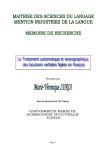
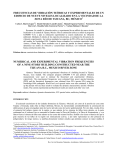
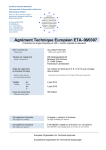
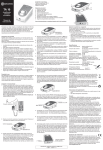
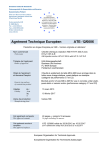


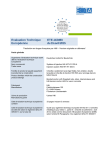

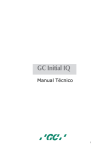
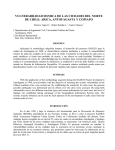



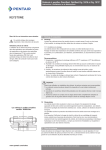

![[A] e) Scheda 2 - Lista Lavorazioni](http://vs1.manualzilla.com/store/data/006108840_1-8ffffbd7c5e49c872e7e4176fdd7c40b-150x150.png)

